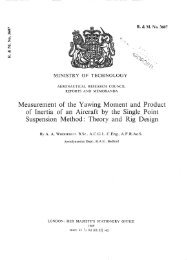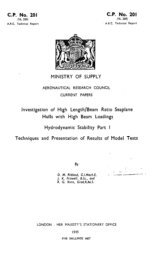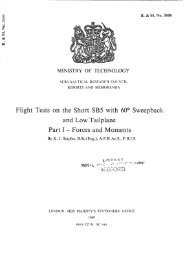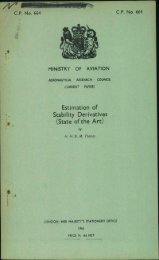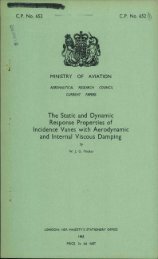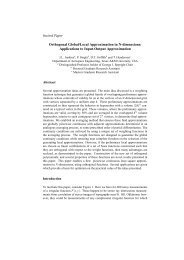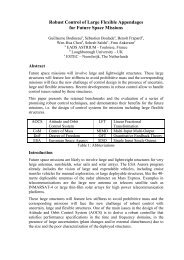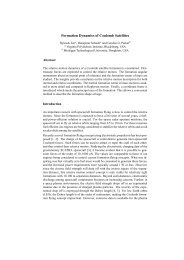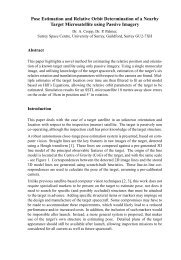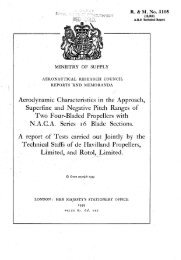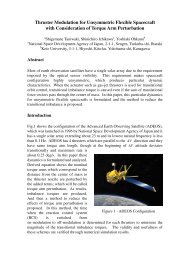The Aerodynamic Characteristics of Flaps
The Aerodynamic Characteristics of Flaps
The Aerodynamic Characteristics of Flaps
Create successful ePaper yourself
Turn your PDF publications into a flip-book with our unique Google optimized e-Paper software.
permissible. Quick operation is also generally desirable. A further requirement is that in operation<br />
they should not induce unpleasant buffeting or vibration <strong>of</strong> the controls or <strong>of</strong> the aircraft as a<br />
whole.<br />
Generalisations, based on existing data, <strong>of</strong> a kind that will enable a designer to predict all<br />
the important characteristics <strong>of</strong> brake flaps for any given design are impossible. <strong>The</strong> best that<br />
can be done is to discuss the relations between these characteristics and the factors that control<br />
them in a broad and mainly qualitative manner, and to refer the reader to existing summaries<br />
or collections <strong>of</strong> data (e.g., Refs. 110, 111, 118) for more detailed guidance.<br />
11.2. Drag.--For brake flaps we are interested in the drag increment at a constant lift rather<br />
than at a constant incidence.<br />
<strong>The</strong> main variables <strong>of</strong> which the drag increment <strong>of</strong> a brake flap is a function are its area, geometry,<br />
chordwise position, the wing thickness and the lift coefficient. Very roughly, one can say<br />
that at small values <strong>of</strong> CL the drag coefficielit increment <strong>of</strong> a brake flap in terms <strong>of</strong> its area is<br />
about 1.1 sin"/~ when the flap is at the wing trailing edge, and this coeffÉcient rises with forward<br />
movement <strong>of</strong> the flap to nearly 3 sin s/~ when the flap is at about the wing quarter-chord point ;<br />
the drag coefficient increment then falls rapidly if the flap is moved ahead <strong>of</strong> that point. At a<br />
CL <strong>of</strong> 0.5, the drag coefficient increment <strong>of</strong> the flap on the lower surface is about 1.5 sin" ~ if the<br />
flap is at the trailing edge and falls slightly if the flap is moved forward ; with the flap on the<br />
upper surface the increment is only about 0.2 to 0.3 sin s/~ when the flap is at the trailing edge<br />
but it rises rapidly with forward movement <strong>of</strong> the flap to about 4.5 sin"/3 when the flap is at the<br />
quarter-chord point. In Ref. 110 it is suggested that some consistency <strong>of</strong> data can be obtained<br />
by expressing the increment in terms <strong>of</strong> the area S/, where<br />
S/ = b~(c~ + tl), • . . . . . . . . . . . . . (26)<br />
b I is the span <strong>of</strong> the flap, c I is the chord <strong>of</strong> the't]ap, tl is the normal distance from the wing surface<br />
to the chord line in the plane <strong>of</strong> the flap hinge.<br />
Some representative values <strong>of</strong> the drag coefficient increment based on S/ and denoted by<br />
ACBv are reproduced from Ref. 110 in Fig. 23c.* Where more than one flap is used, the drag<br />
coefficient increments can be taken as additive.<br />
Brake flaps are frequently perforated or slotted to reduce buffeting and vibration. <strong>The</strong> estimated<br />
drag increments should be reduced in the proportion <strong>of</strong> open area to total flap area,<br />
except in the case <strong>of</strong> round perforations for which the available evidence suggests the estimated<br />
values should be reduced in the proportion <strong>of</strong> half the open area to total flap area.<br />
11.3 Lift.--<strong>The</strong> lift effect <strong>of</strong> aflap aft <strong>of</strong> about 0.5c on either the upper or lower surface <strong>of</strong> a wing<br />
can be. estimated with fair accuracy from the curves <strong>of</strong> Figs. 5, 6, using the concept <strong>of</strong> reduced<br />
chord.i- Alternatively, the detailed results collected in Refs. 110 and 111 may be used for<br />
guidance. In Ref. 110 the device has been used <strong>of</strong> expressing the lift coefficient increment in<br />
terms <strong>of</strong> S/, i.e., the increment is expressed as<br />
S<br />
ACBL = A CL~- . . . . . . . . . . . . . . . (27)<br />
Mean curves <strong>of</strong> A CBL as a function <strong>of</strong> chordwise position <strong>of</strong> flap, deduced from a fair quantity<br />
<strong>of</strong> data, are reproduced in Fig. 23a. <strong>The</strong> scatter is fairly considerable, however, and these curves<br />
should only be used to give a rough estimate, the method, suggested above is probably more<br />
accurate.<br />
In general, the lift effects <strong>of</strong> two flaps are additive, although there is a recorded case ~11 where<br />
with flaps on both surfaces the lift was even less than with the single flap on the upper surface.<br />
11.4. Pitching Moment.--<strong>The</strong> pitching moment change produced by a brake flap derives from<br />
(1) the change in the wing pitching moment due to the flap,<br />
(2) the change in downwash produced at the tail plane.<br />
* <strong>The</strong>re must clearly be some lower limit to the size <strong>of</strong> flap chord for which this method <strong>of</strong> representation can apply,<br />
since the method gives a drag increment other than zero when c s = 0.<br />
-~ For upper surface flap A C~' is negative.<br />
21



